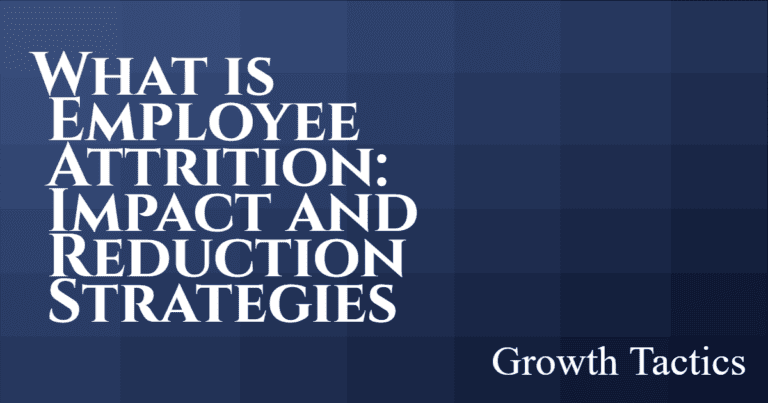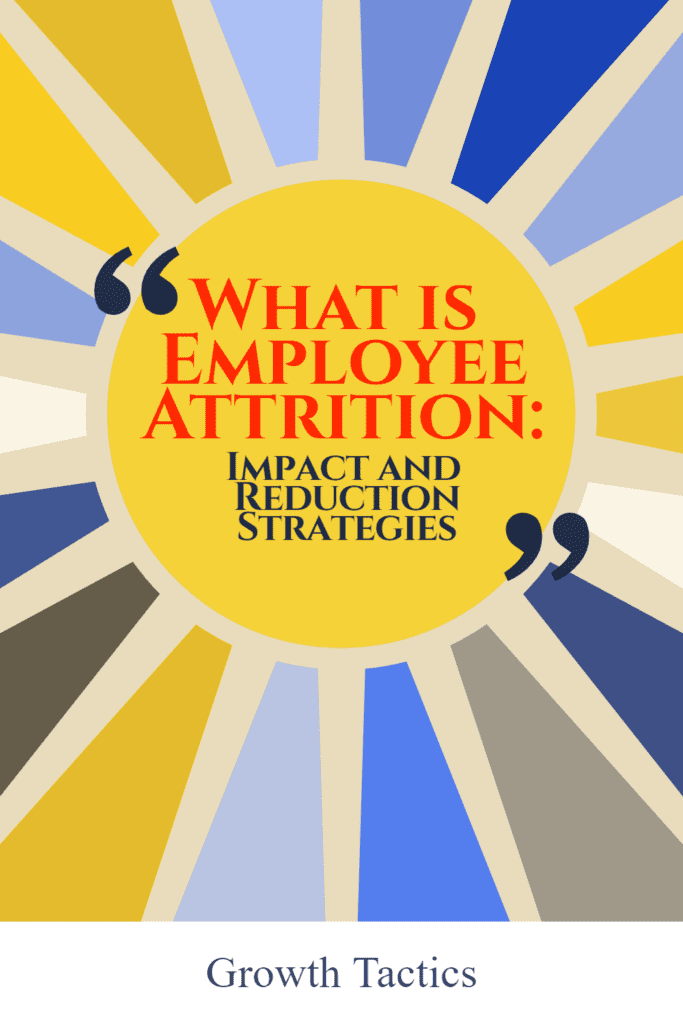Employee attrition, or turnover, is a vital concern for organizations. It refers to the number of employees who leave a company over time. In this article, we will explore the impact of employee attrition and strategies to reduce it. We will also discuss different types of attrition, common reasons for employees leaving, and the importance of employee engagement and satisfaction in employee retention efforts. Let’s dive in.
Jump To Section
Impact of Employee Attrition
Employee attrition has significant implications for organizations. It disrupts workflow, increases recruitment and training costs, and lowers employee morale. The following are some key impacts of employee attrition.
Productivity and Performance
High attrition rates can have a detrimental effect on productivity and overall performance. When employees leave, it can lead to a loss of valuable skills, knowledge, and experience. Moreover, the remaining employees may need to take on additional responsibilities, resulting in increased workloads and potential burnout.
Financial Costs
The financial costs associated with employee attrition can be substantial. Organizations incur expenses in recruiting and training new employees to fill vacant positions. Additionally, high attrition rates can lead to decreased customer satisfaction and revenue loss.
Workforce Stability
Attrition can destabilize the workforce, causing disruptions in project completion and team dynamics. Repeated turnover can harm the overall stability and cohesiveness within departments or organizations.
Types of Employee Attrition
Employee attrition refers to the departure of employees from an organization. Understanding the different types of attrition can help organizations identify patterns and potential areas for improvement. Here are some common types of employee attrition:
1. Voluntary Attrition
Voluntary attrition occurs when employees choose to leave the organization on their own accord. This can be due to various reasons, such as seeking career advancement opportunities, better compensation and benefits, dissatisfaction with the work environment, or personal reasons. Voluntary attrition is often a significant concern for organizations, as it indicates that employees are actively seeking alternative employment options.
2. Involuntary Attrition
Involuntary attrition refers to the departure of employees due to circumstances beyond their control. This can include layoffs, restructuring, or termination for performance or disciplinary reasons. In some cases, organizations have to downsize or make difficult decisions that lead to involuntary attrition. It is important for organizations to handle involuntary attrition with sensitivity and transparency to maintain employee morale and preserve the employer brand.
3. Retirement Attrition
Retirement attrition occurs when employees leave the organization upon reaching the age of retirement. As the workforce ages, organizations often face a significant number of retirements, especially in industries with an aging workforce. Organizations should plan for succession and knowledge transfer to minimize the impact of retirement attrition on critical roles and institutional knowledge.
4. Internal Attrition
Internal attrition happens when employees leave their current positions but remain within the organization in different roles or departments. This type of attrition can occur when employees seek new challenges, career advancement, or desire to explore different areas of the organization. Internal attrition can be beneficial for organizations, as it allows employees to bring new skills and perspectives to various roles while retaining valuable talent within the company.
5. External Attrition
External attrition refers to employees leaving the organization to join another company or industry. This can occur when employees receive better offers, find opportunities for growth and development elsewhere, or are attracted by different organizational cultures. External attrition can be influenced by factors such as market competition, compensation packages, and overall job market conditions. Tracking external attrition can help organizations understand their competitiveness in attracting and retaining talent.
By recognizing and understanding these different types of employee attrition, organizations can identify trends, develop targeted retention strategies, and take proactive measures to reduce turnover. It is important for organizations to maintain open lines of communication, conduct regular assessments of employee satisfaction, and address concerns to minimize attrition and create a positive and engaging work environment.
Strategies for Addressing Each Type of Attrition
To effectively address different types of employee attrition, organizations can implement specific strategies tailored to each situation. Here are some strategies for addressing each type of attrition:
1. Voluntary Attrition
-
Enhance employee engagement: Create a positive work environment that fosters employee satisfaction and engagement. Provide opportunities for growth, recognition, and work-life balance.
-
Evaluate compensation and benefits: Regularly review and benchmark compensation and benefits packages to ensure they remain competitive in attracting and retaining top talent.
-
Conduct stay interviews: Engage in frequent conversations with employees to understand their motivations and concerns, proactively addressing potential issues before they lead to attrition.
-
Provide career development opportunities: Offer training, mentoring programs, and clear career progression plans to demonstrate commitment to employee growth and development.
2. Involuntary Attrition
-
Handle terminations with sensitivity: Provide transparent communication and support during restructuring or layoffs to maintain employee morale and minimize the negative impact on remaining staff.
-
Offer outplacement services: Provide resources and support, such as resume building and job search assistance, for employees affected by involuntary attrition to help them transition smoothly to new opportunities.
-
Conduct post-attrition evaluations: Evaluate the factors leading to involuntary attrition to identify areas for improvement in talent management, performance management, and employee development.
3. Retirement Attrition
-
Develop succession planning strategies: Identify key roles and competencies within the organization and create development plans for potential successors to ensure a smooth transition and minimize knowledge loss.
-
Encourage knowledge transfer: Facilitate knowledge transfer through mentoring programs, documentation, and cross-training to capture and preserve institutional knowledge before employees retire.
-
Implement phased retirement options: Offer flexible retirement arrangements, such as reduced hours or part-time schedules, to retain valuable expertise while supporting employees in their transition to retirement.
4. Internal Attrition
-
Offer internal mobility opportunities: Promote internal job postings, cross-departmental transfers, and promotions to provide employees with new challenges and growth opportunities within the organization.
-
Implement talent development programs: Identify high-potential employees and provide them with training, mentorship, and stretch assignments to retain and develop top talent.
-
Conduct career path discussions: Engage in regular conversations with employees to understand their career aspirations and help align their goals with available opportunities within the organization.
5. External Attrition
-
Conduct exit interviews: Gather feedback from departing employees to understand their reasons for leaving and identify areas for improvement in the organization’s employee value proposition.
-
Enhance employer brand: Build a strong employer brand by consistently communicating the organization’s values, culture, and development opportunities to attract and retain top talent.
-
Conduct competitive market analysis: Regularly assess the job market to ensure the organization’s compensation, benefits, and career opportunities remain competitive to attract and retain high-performing employees.
By implementing these strategies specific to each type of attrition, organizations can effectively address the underlying causes and work towards reducing employee attrition rates. It is important for organizations to continuously assess and adapt their retention strategies to create a positive and engaging workplace that supports employee satisfaction and long-term commitment.
Measuring and Monitoring Employee Attrition
To effectively address employee attrition, organizations need to measure and monitor their attrition rates. This allows them to assess the effectiveness of their retention strategies and make data-driven decisions. The following sections outline key methods for measuring and monitoring employee attrition.
Calculating Attrition Rate
Calculating the attrition rate involves determining the percentage of employees who leave the organization within a specific time period. The formula commonly used to calculate turnover rates is:
Attrition Rate = (Number of Employees Left / Average Number of Employees) × 100
By tracking attrition rates over time, organizations can identify trends and patterns, allowing them to take proactive measures to reduce attrition.
Conducting Exit Interviews
Exit interviews provide an opportunity to gather feedback from departing employees. These interviews can reveal valuable insights into the reasons for attrition, such as dissatisfaction with work conditions or lack of growth opportunities. Organizations can use the information gathered from exit interviews to identify areas for improvement and refine their retention strategies.
Employee Satisfaction Surveys
Regularly conducting employee satisfaction surveys helps measure the overall satisfaction and engagement levels of employees. These surveys can capture information about work environment, leadership, compensation, and other factors that may impact attrition. Analyzing survey results can highlight areas of concern and guide efforts to improve employee satisfaction and retention.
Tracking Employee Engagement
Monitoring employee engagement levels is another important measure of attrition risk. High levels of employee engagement often correlate with lower attrition rates. Regularly tracking and analyzing employee engagement through surveys, feedback channels, or performance indicators can help organizations identify potential attrition risks and take appropriate actions.
Benchmarking Employee Turnover
Benchmarking involves comparing attrition rates and retention strategies with industry peers or best practices. By benchmarking, organizations can gain insights into their attrition performance and identify areas of improvement. This information can guide the development of targeted retention initiatives and ensure competitiveness in the job market.
Conclusion
Employee attrition is a significant challenge that organizations face, and it is crucial to understand the different types of attrition and implement appropriate strategies to address them. By measuring and monitoring attrition rates, conducting exit interviews, and analyzing employee satisfaction and engagement, organizations can gain insights into the reasons behind attrition and identify areas for improvement.
Overall, organizations need to invest in creating a positive work environment, providing growth opportunities, and regularly communicating with employees to address attrition effectively. By implementing targeted strategies, organizations can lower attrition rates, retain top talent, and create a culture of engagement and commitment.
Reducing attrition rates not only improves organizational stability but also allows companies to maintain institutional knowledge, foster employee growth, and create a positive employer reputation in the job market. By prioritizing employee satisfaction and retention, organizations can build a strong and resilient workforce that contributes to long-term success.


